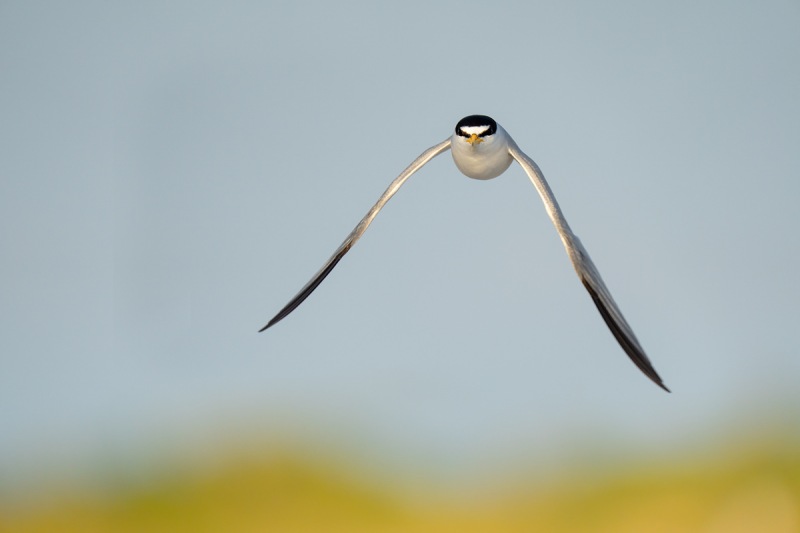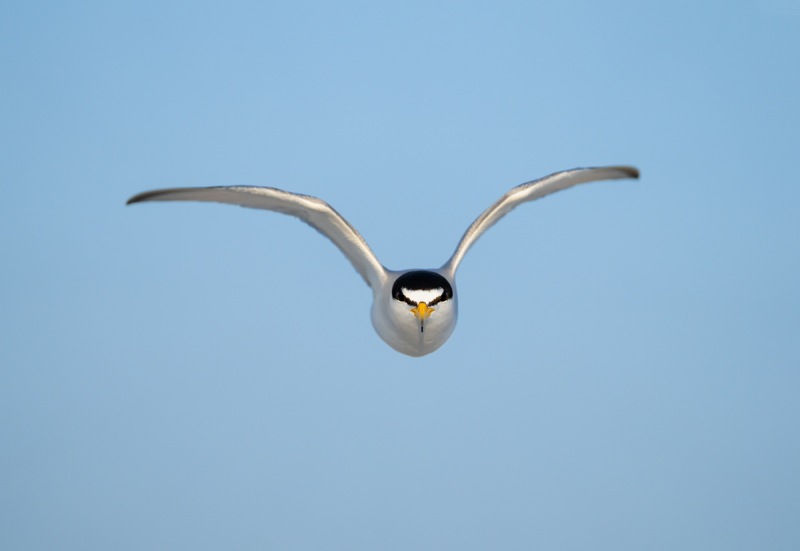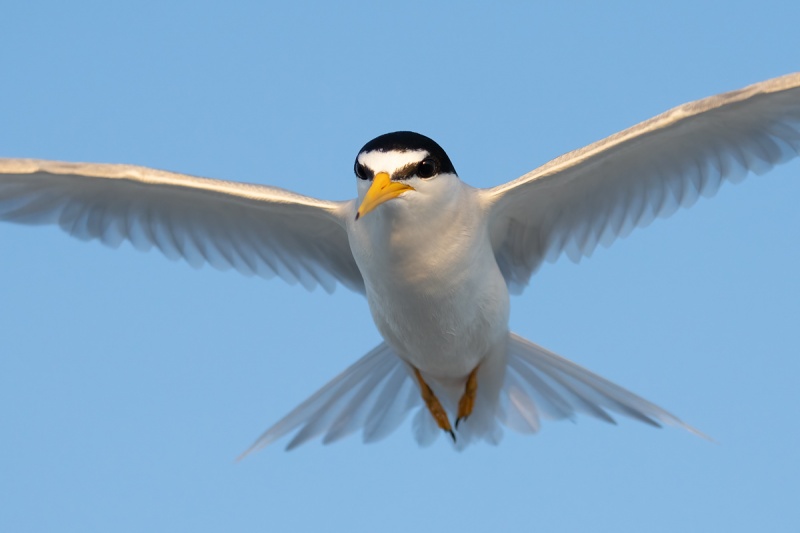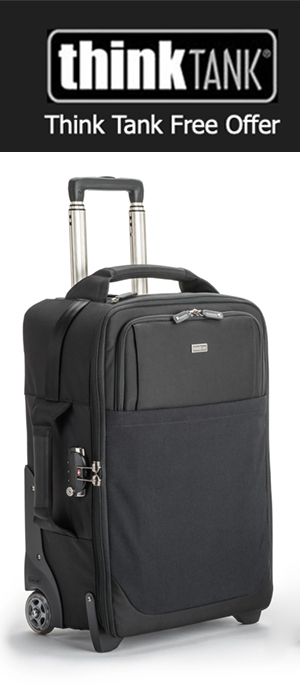Your Fave?
Which is the strongest flight shot? If you leave a comment, please let us know why you made your choice.
What’s Up?
I got to the beach at 6:30am on Wednesday. Clemens was off biking with his group; they did a tidy 25 miles. Then Clemens had a Zoom meeting. It was pretty dark at first — I started photographing Least Tern chicks standing still on the beach at eye level at 1/250 sec. at f/4 at ISO 3200. As I said, it was pretty dark. Things got better as far as light was concerned but I was pretty much not feeling it. Every time I tried for a flight or action shot I was too late. So I concentrated on photographing the adults that landed on the beach for more than a second with all manner of fishes and other sea creatures for their chicks. It was cloudy-bright and the wind was shifting from the southwest to the east so I called Clemens, and he did indeed drive to the beach with his wife Audrey. We wound up leaving the beach at 1:30pm, that after I filled a large flash card (160GB) for the first time ever: 2950 a1 images. I tried garbage-canning a bunch of mis-framed images in the field — I have never had to do that before, but I could barely make a dent and quickly re-filled the card.
It had been like a pressure cooker — super high humidity and zero breeze. At about 1:00pm a front came through with a cool onshore breeze soon followed by thunder, lightning, and rain. We got off the beach at just the right time. After shooting for seven straight hours, I was beyond knackered. We drove back to Clemens’ place where I ate my first meal of the day. And then I took a long nap. Clemens worked on some images and then headed back to the beach for more Least Tern chick action.
As the Sony Alpha a1 is becoming more readily available, the Alpha a1 Set-up and Info Group has grown to an astounding 57 folks! Most folks have earned free entry into the group by getting their bodies from Bedfords or from B&H.
Today is Thursday, 17 June 2021. The forecast for Southeast Florida for this morning is for an east wind with clouds and scattered thunderstorms. I will head home after the morning shoot. Wherever you are, and whatever you are doing, I hope that you too have a great day.
This blog post took about two hours to prepare and makes 173 consecutive days with a new one. Please remember that if an item — a Delkin flash card, or a tripod head — for example, that is available from B&H and/or Bedfords and is also available in the BAA Online Store, it would be great if you opt to purchase from us. We will match any price. Please remember also to use my B&H affiliate links or to save 3% at Bedfords by using the BIRDSASART discount code at checkout. Doing either often earns you free guides and/or discounts. And doing so always earns my great appreciation.
Please Remember
With income from IPTs now close to zero, please, if you enjoy and learn from the blog, remember to use one of my two affiliate programs when purchasing new gear. Doing so just might make it possible for me to avoid having to try to get a job as a Walmart greeter and will not cost you a single penny more. And if you use Bedfords and remember to enter the BIRDSASART code at checkout, you will save 3% on every order and enjoy free second-day air shipping. In these crazy times — I am out at least forty to sixty thousand dollars so far due to COVID 19 (with lots more to come) — remembering to use my B&H link or to shop at Bedfords will help me out a ton and be greatly appreciated. Overseas folks who cannot order from the US because of import fees, duties, and taxes, are invited to help out by clicking here to leave a blog thank you gift if they see fit.
New and Better Bedfords Discount Policy!
You can now save 3% on all of your Bedfords photo gear purchases by entering the BIRDSASART coupon code at checkout. Your discount will be applied to your pre-tax total. In addition, by using the code you will get 2nd day air shipping via Fed Ex.
Grab a Nikon AF-S Teleconverter TC-14E III and save $14.99. Purchase a Canon EOS R5 and your discount will be $116.97. Purchase a Sony FE 600mm f/4 GM OSS lens and save a remarkable $389.94! Your Bedford’s purchase no longer needs to be greater than $1,000.00 for you to receive a discount. The more you spend, the more you save.
Money Saving Reminder
Many have learned that if you need a hot photo item that is out of stock at B&H and would enjoy free second-day air shipping, your best bet is to click here, place an order with Bedfords, and enter the coupon code BIRDSASART at checkout. If an item is out of stock, contact Steve Elkins via e-mail or on his cell phone at (479) 381-2592 (Central time). Be sure to mention the BIRDSASART coupon code and use it for your online order to save 3% and enjoy free 2nd-day air shipping. Steve has been great at getting folks the hot items that are out of stock at B&H and everywhere else. The wait lists at the big stores can be a year or longer for the hard to get items. Steve will surely get you your gear long before that. For the past year, he has been helping BAA Blog folks get their hands on items like the SONY a9 ii, the SONY 200-600 G OSS lens, the Canon EOS R5, the Canon RF 100-500mm lens, and the Nikon 500mm PF. Steve is personable, helpful, and eager to please.


Gear Questions and Advice
Too many folks attending BAA IPTs (remember those?) and dozens of photographers whom I see in the field and on BPN, are–out of ignorance–using the wrong gear especially when it comes to tripods and more especially, tripod heads… Please know that I am always glad to answer your gear questions via e-mail.
|
|
|
This image was created on 27 May 2021 at Fort DeSoto Park. I used the hand held Sony FE 200-600mm f/5.6-6.3 G OSS lens (at 600mm) and The One, the Sony Alpha 1 Mirrorless digital camera. ISO 800. Exposure determined via Zebras with ISO on the rear dial: 1/3200 sec. at f/7.1 (wide open) in Manual mode. AWB at 7:20pm on a dead-clear afternoon. Wide/AF-C was active at the moment of exposure and performed as expected: perfectly. Click on the image to see a larger version. Image #1: Least Tern — wings down, facing flight |
A Whole New World: Picking Your Flight Keepers
While picking my keepers from a good afternoon of Least Tern flight photography on Thursday afternoon past, I had some thoughts that I wanted to share with you here. I created more than 1600 images in a 90 minutes session. The wind was strong from the west and there was lots of action. The vast majority of the images were sharp or razor-sharp on the eye or eyes. Less than a handful of my a1/200-600 images were totally out-of-focus, all of those due to operator error. I kept less than 50 on the first edit. Editing the relatively huge file took me about 15 minutes, in part because I know exactly what I am looking for: I know what works and what does not. And in part because of the great speed that Photo Mechanic attains with a1 raw files; if you keep the button down, it’s like watching a movie.
Many of the images were mis-framed with various parts of the bird cut off by the frame-edge (operator error again).
What struck me was that I deleted well more than a thousand sharp, well-composed, well lit images of the fast tiny birds in flight, was that each one of those would have been a solid keeper just a year or two before. Well more than a thousand. Now we are looking for those special images, ones that stand out as relatively spectacular, usually because of the wing position or the flight pose. And sometimes because of the size of the bird in the frame and/or outstanding sharpness. As always, and as discussed here recently, we are looking for those images that are different and special. Super-sharp and in the center of the frame no longer cuts it …
|
|
|
This image was created on 27 May 2021 at Fort DeSoto Park. I used the hand held Sony FE 200-600mm f/5.6-6.3 G OSS lens (at 600mm) and The One, the Sony Alpha 1 Mirrorless digital camera. ISO 800. Exposure determined via Zebras with ISO on the rear dial: 1/2500 sec. at f/6.3 (wide open) in Manual mode. AWB at 7:28pm on a dead-clear afternoon. Wide/AF-C was active at the moment of exposure and performed as expected: perfectly. Click on the image to see a larger version. Image #2: Least Tern flight looking serious |
Pugnacious!
This one made it as a keeper because of the pugnacious look on the bird’s face. If you see anything strange about the processing of this image, please leave a comment.
|
|
|
This image was created on 27 May 2021 at Fort DeSoto Park. I used the hand held Sony FE 200-600mm f/5.6-6.3 G OSS lens (at 200mm) and The One, the Sony Alpha 1 Mirrorless digital camera. ISO 1250. Exposure determined via Zebras with ISO on the rear dial: 1/2000 sec. at f/6.3 (wide open) in Manual mode. AWB at 7:47pm on a clear afternoon. Wide/AF-C was active at the moment of exposure and performed as expected: perfectly. Click on the image to see a larger version. Image #3: Least Tern point-blank flight |
Super-tight Flight
This one survived the cut because the bird was so large in the frame and so sharp that I needed to crop in just a bit for a pleasing image design.
SONY 200-600 G Lens
As discussed yesterday, when the sun is shining, the SONY 200-600 G lens can be deadly, especially for bird in flight when the wind is coming from somewhere behind you.
Sony Alpha a1 AF
Barring operator error, the performance of the Sony Alpha a1 AF system at any focal length — including at 1200mm as seen in recent blog posts — is, when the a1 is set up properly as detailed in the in e-mails to the Sony Alpha a1 Info & Updates group, more than remarkable. Early on, there was lots of discussion within the group with many preferring multiple back button approaches. For me a simple shutter button approach with the right AF settings that yield 99% sharp-on-the-eye images is best. By far. It is super-simple and mega-effective. In recent SONY Alpha a1 Set-up and Info Group e-mails, I shared what I have learned as to when and it what situations it is best to abandon Wide. And with what. The group has already learned to limit the AF Area choices and to switch AF Areas quickly and conveniently. The default method of switching AF points with the C2 button is both slow and cumbersome. In addition, recent e-mails have detailed the best program to use to pick your a1 keepers and the big problem with the Camera Set. Memory menu item.
SONY Alpha a1 Set-up and Info Group
For me, today’s featured image would not have been possible without my Sony Alpha a1. The speed of initial focusing acquisition is amazingly quick as is the tracking accuracy. And all of that will be even truer for tomorrow’s featured image.
The SONY Alpha a1 Set-up and Info Group is going great guns as folks chime in with thoughtful questions and experience-based advice. We are now up to an astounding 57 blessed folks! Early on, we discussed the myriad AF options. I gave my opinion as to the best one for flight and general bird photography. More recently, we have been in contact with folks at SONY sharing our thoughts, experiences, and frustrations with the EVF blackout problem.
All who purchased their Alpha a1 bodies via a BAA affiliate link will receive a free subscription to the Sony Alpha a1 Set-Up and Info Updates after shooting me their receipts via e-mail. (Note: it may take me several days to confirm B&H orders.) This same service may be purchased by anyone with an a1 body via a $150.00 PayPal sent to birdsasart@verizon.net indicating payment for Alpha a1 Info Updates. Alternatively, folks can call Jim weekdays at 1-863-692-0906 to pay via credit card. New members will receive composite e-mails that summarize all previous discussions.
Typos
With all blog posts, feel free to e-mail or to leave a comment regarding any typos or errors.


















#3 for me, easy choice. The leading edges of the wings look yellowish. Is that due to processing or was that how they looked? I still have trouble discarding s razor-sharp well-composed flight image–not that I get so many–but I know what you mean. I do get a lot with cranes and geese and I try to use criteria like you described.
If it is a fast flying bird I am on 1/3000 or 1/2500. If it is an animal walking on the ground I am on 1/1000 or 1/1500 and I have to also check on others to be OK for the light above us for bright sun or clouds or later afternoon.
All 3 above are good (and cute!)
Number 3 for me, I love the feather detail and light in the eye!
The third one, for sure. I like seeing the whole head of the bird — and the face on this one is priceless. I also like the tail and the position of the feet.
Tough choices, but I’d go with the least tern tight crop. It’s the eye with that little glint of catch light. I was also leaning towards the least tern downstroke. I like how the head is just off center directing the viewer to see the bird moving toward the left side of the frame, and the yellow/gold color at the bottom of the image.